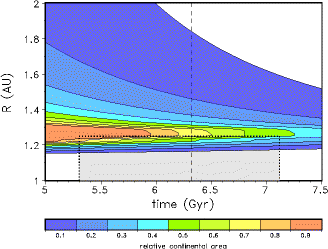 |
||||
| Werner von Bloh
|
|||||
| The Habitable Zone of Earth-Mass Planets Around 47 UMa: Results for Land and Water Worlds |
|
||||
S. Francka, M. Cuntzb, W. von Bloha, and C. Bounamaa aPotsdam Institute for Climate Impact Research (PIK), Telegrafenberg, P.O. Box 60 12 03, 14412 Potsdam, Germany. bDepartment of Physics, University of Texas at Arlington, Box 19059, Arlington, TX 76019, USA.
In a previous paper, we showed that Earth-type habitable planets around 47 UMa are in principle possible if a distinct set of conditions is warranted. These conditions include that the Earth-type planets have successfully formed and are orbitally stable and, in addition, that the 47 UMa star-planet system is relatively young (< 6 Gyr). We now extend this study by considering Earth-like planets with different land / ocean coverages. This study is again based on the so-called integrated system approach, which describes the photosynthetic biomass production taking into account a variety of climatological, biogeochemical, and geodynamical processes. This approach implies a special characterization of the habitable zone defined for a distinct type of planet. We show that the likelihood to find a habitable Earth-like planet on a stable orbit around 47 UMa critically depends on the percentage of the planetary land / ocean coverage. The likelihood is significantly increased for planets with a very high percentage of ocean surface ("water worlds"). Keywords: Extrasolar planets, geodynamics, habitable zone, orbital stability and planetary climate.
Figure: The habitable zone around 47 UMa for the likely value of luminosity of L=1.54 Ls. The colored areas indicate the extent of the HZ for different relative continental areas. The grey shaded area indicates the permissible parameter space as constraint by the stellar age and the orbital stability limit at 1.25 AU. |
|||||
|
|
|||||
| Impressum © PIK 2006 |
